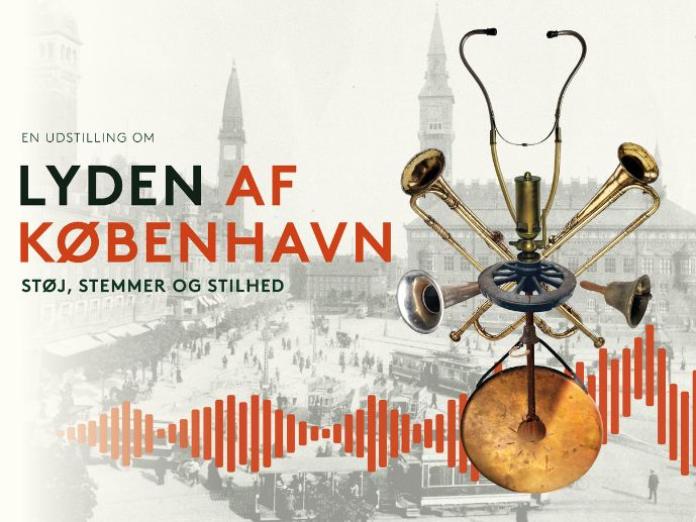Press release: THE SOUND OF COPENHAGEN - Noise, Voices and Silence
2025 is the Year of Sound at the Museum of Copenhagen. The entire year is dedicated to the museum’s long-standing focus on the art and history of sound with a sound exhibition, new books, a sound art commission and a packed event programme of talks, concerts, workshops and pop-up exhibitions exploring Copenhageners’ relationship to sound past and present. Central to this year’s programme is THE SOUND OF COPENHAGEN - Noise, Voices and Silence.
If you tune in and listen carefully, you’ll start to notice that Copenhagen is full of sounds. The constant hum of traffic, shrieks from the rides at Tivoli, sirens, bicycle bells, the beeping of metro doors and the rhythmical boom of pile drivers on construction sites. All of them part of the unique soundtrack of Copenhagen with the iconic bells of City Hall marking the passage of the day and ringing in the New Year for the entire nation.
In May 2025 the Museum of Copenhagen opens it door to the exhibition THE SOUND OF COPENHAGEN 1800-1920: Noise, Voices and Silence, a sensory exhibition that puts sound and listening firmly centre stage. The focus is 19th-century Copenhagen, when some of the most dramatic changes in the city’s soundscape took place. The Danish capital went from being an overcrowded walled city to become a modern, industrialised, pulsating metropolis that more than quadrupled in size. Sound levels boomed at the same time as people’s sensitivity to noise increased. Early in the century new ideals about the tranquillity of the home as a place for recreation and family togetherness emerged, and people started to make complaints about the noise of street criers, rumbling carts, church bells and barking dogs. Industrialisation made Copenhagen noisier than ever, and new sounds like factory whistles and trams bells rang across the city as part of the new soundtrack of the city and a new understanding of what it meant to be a Copenhagener.
Sounds Connecting the City
The exhibition, a collaboration between the Museum of Copenhagen and experience design studio Yoke, has three tracks. It opens with a zone dedicated to Noise inviting visitors inside a total installation of the chaotic soundscapes of the past with sounds from the harbour, factories, Tivoli, Copenhagen Central Station, City Hall Square and local neighbourhoods. This cacophony of sounds ranges from the cry of seagulls, steamships in the harbour and the infernal noise of factory whistles, to fireworks at Tivoli, bicycle bells and the iconic sound of the bells of City Hall. En route visitors can see the complaints Copenhageners made about everything from pets to piano playing and the din of backyard industries, proving that what is intolerable noise for some is music to the ears of others.
The Amplifying City
In the Voices zone of the exhibition we turn to the way the walls and streets of the city were used as amplifiers. From street hawkers, whose cries were finely tuned to the city surrounding them over the centuries, to the bells, gongs, trumpets and drums that have been used to demonstrate and manifest power in the Danish capital.
The Power of Silence
The Silence section of the exhibition turns to the quest for peace and quiet as a contrast to the noise of the city, and the use of silence as a disciplinary and correctional measure. Given the sensory bombardment of city life, many took refuge in Copenhagen’s parks, residential neighbourhoods and at sanatoriums. Others, in schools, prisons and workhouses, had silence forced on them. In this zone visitors can listen to the silence of the sanatorium, park, school and workhouse.
Open Your Ears
The relationship people in Copenhagen had to sound and listening changed radically In the 19th century. The stethoscope, telegraph, phonograph and telephone all made previously unheard sounds inside the body and in the outside world audible, at the same time as making it possible to record, save and listen to sounds in different times and places. It was a listening revolution. Today we also find ourselves in the midst of a listening revolution where science, technology and sound art are pushing the boundaries of how we listen to the world, the city and ourselves. Via smartphones, podcasts, audio streaming, ear-pods and noise-cancelling headphones we can choose the soundtrack of our own lives. But it could be time to take off our headphones and listen to the Sound of Copenhagen? We might discover more than we imagined possible.
A City without Sound
In developing the exhibition the Museum of Copenhagen has collaborated with the CFD and a group of young people with severe hearing loss. As visitors leave the exhibition, they can see a cochlear implant used to create an artificial hearing experience for those with seriously impaired hearing. Despite sounding like a miracle, the technology is not without its downsides. It can, for example, prevent those with the implant from learning sign language and result in exclusion from communication among members of the deaf community.
Learn more about the exhibition
https://cphmuseum.kk.dk/en/visit-us/current-exhibitions/special-exhibition-the-sound-of-copenhagen
The exhibition has been made possible thanks to the support of:
THE VELUX FOUNDATION
THE AUGUSTINUS FOUNDATION
THE KNUD HØJGAARD FOUNDATION
Practical information
Admission to the special exhibition is included in the ticket to the Museum of Copenhagen.
Tickets can be purchased at the museum or via: www.copenhagen.dk
The admission ticket grants access to the Museum of Copenhagen, Thorvaldsen’s Museum, and Nikolaj Kunsthal for 48 hours after ticket activation. The ticket must be used within 180 days of the purchase date; after that, it becomes invalid.
- Every Wednesday, admission is free for everyone.
- On Tuesdays, admission is also free for pensioners.
- Please note: children and young people under 18 years of age have free admission and therefore do not need to purchase a ticket.
Address
Stormgade 18, 1555 Cph V
Contacts
Press
Camilla Kjær Pedersen
Mail: Es70@kk.dk
Mobil: 4019 7485
Exhibition
Jakob Ingemann Parby
Seniorforsker, museumsinspektør
Mail jakobp@kk.dk
Mobil 2382 0931
